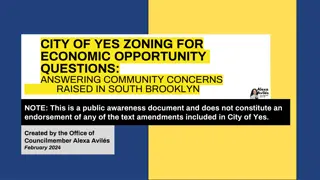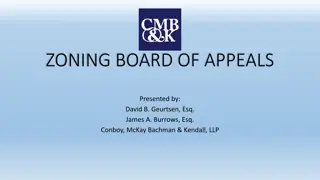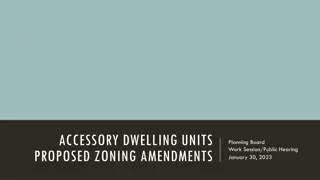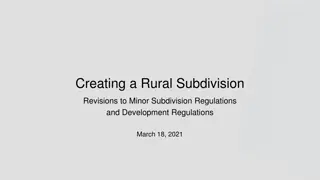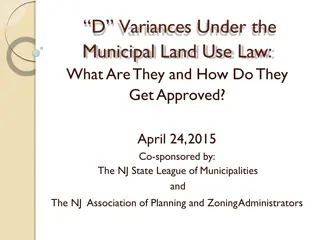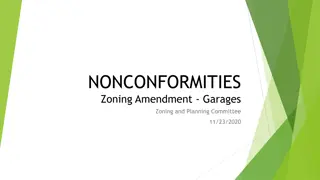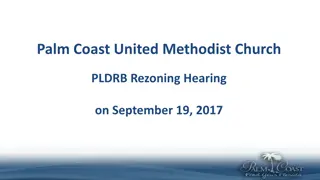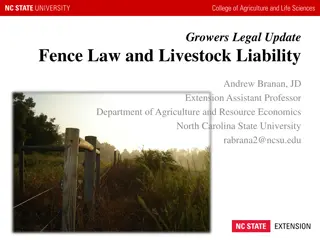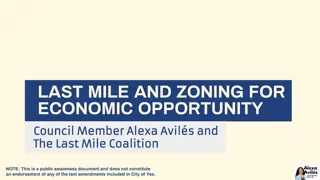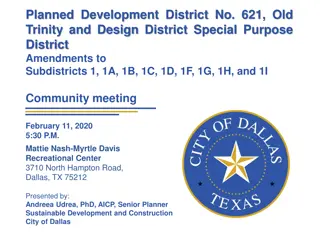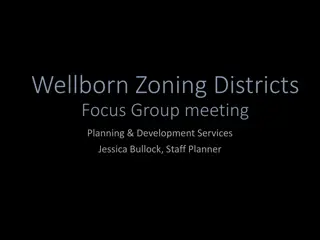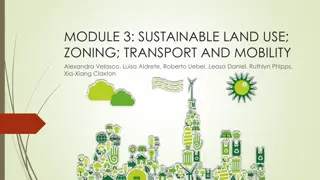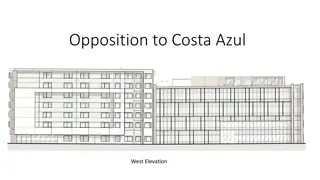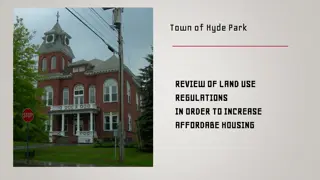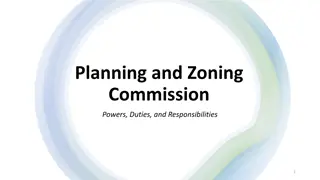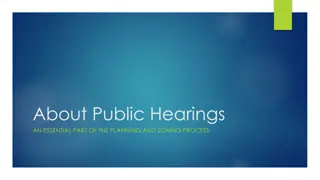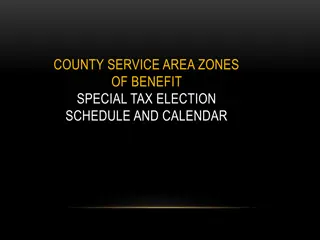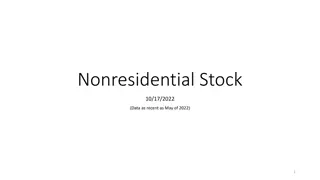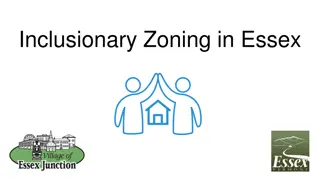Zoning and Development Regulations Summary and Changes
This summary discusses the key points of Public Act 21-29 prepared by WestCOG. It includes details on procedural provisions, development review fees and processes, PZC training requirements, non-discrimination in decision-making, and changes to the zoning framework. The Act emphasizes efficient review of proposals, training for zoning boards, non-discrimination in decision-making, and updates to zoning regulations.
Download Presentation

Please find below an Image/Link to download the presentation.
The content on the website is provided AS IS for your information and personal use only. It may not be sold, licensed, or shared on other websites without obtaining consent from the author.If you encounter any issues during the download, it is possible that the publisher has removed the file from their server.
You are allowed to download the files provided on this website for personal or commercial use, subject to the condition that they are used lawfully. All files are the property of their respective owners.
The content on the website is provided AS IS for your information and personal use only. It may not be sold, licensed, or shared on other websites without obtaining consent from the author.
E N D
Presentation Transcript
PA 21-29 SUMMARY Prepared by WestCOG
SOURCES Public Act 21-29: https://www.cga.ct.gov/2021/ACT/PA/PDF/2021PA-00029-R00HB-06107-PA.PDF Bill Analysis by the Office of Legislative Research https://www.cga.ct.gov/2021/BA/PDF/2021HB-06107-R010716-BA.PDF
DEVELOPMENT REVIEW FEES AND PROCESS Changes Notes 1. Zoning to promote efficient review of proposals and applications 2. Municipalities had already been doing this 2. Commissions may charge reasonable fees for technical review 3. Incentive to move technical capacity out of town hall (outsource/privatize) 3. For use by consultants only (NOT salaried municipal employees) 4. Fees can charged be for projects requiring extra technical review (e.g., structural for non-code) as long as multifamily treated same 4. May not charge higher fees per dwelling unit, per square foot, OR per unit of construction cost for 8-30g and multifamily (4+ unit) Fees here are not the same as application/permit fees
PZC TRAINING AND ZEO CERTIFICATION Members of planning and/or zoning boards and ZBAs must complete four hours of training within one year from 1/1/2023, with four hours required every two years thereafter At least 1 hour on affordable and fair housing May include training on meetings/hearings and Freedom of Information, interpretation of planning documents, and the impact of zoning on environment, agriculture, and natural resources Commissions must attest annually from 3/1/2024 as to compliance Zoning enforcement officers (ZEOs) must obtain and maintain certification from CAZEO from 1/1/2023
NON-DISCRIMINATION IN DECISION-MAKING No application may be denied on the basis of the immutable characteristics, source of income or income level of any applicant or end user, other than age or disability whenever age-restricted or disability-restricted housing may be permitted Immutable characteristics not defined under state law, unclear if they are the same as protected classes. E.G.: height is not protected but is relatively immutable. Marital status is protected but mutable. Are personality traits and one s life history immutable?
REDEFINITION OF CHARACTER No longer any provision for zoning to consider the character of [a] district , instead reasonable consideration as to the physical site characteristics of the district Applications may NOT be denied on the basis of a district s character, unless such character is expressly articulated in such regulations by clear and explicit physical standards for site work and structures Regs STILL to consider appropriate use of land Agriculture Soil erosion and sediment control Protection of existing and potential public surface and ground drinking water PLUS historic, tribal, cultural, and environmental resources (NEW) PLUS restoration and protection of Long Island Sound (partly NEW)
EXPANSION OF ZONING AUTHORITY Zoning now explicitly shall protect state s historic, tribal, cultural and environmental resources Consider impact of permitted land uses on contiguous municipalities and on the planning region ALSO changes in the area of housing (discussed later, under Housing section) Floating zones, overlay zones, and planned development districts now statutorily provided for for all municipalities (although had been used via court precedent since 1969) Transfer of development rights continues to be allowed
LONG ISLAND SOUND PROTECTION EXTENDED State law has required of coastal municipalities that zoning: Give reasonable consideration for restoration and protection of the ecosystem and habitat of Long Island Sound Be designed to reduce hypoxia, pathogens, toxic contaminants and floatable debris in the Sound Require that the zoning commission consider the environmental impact on Long Island Sound of ANY proposal for development These requirements NOW expanded beyond coastal municipalities to include ALL municipalities on a navigable waterway draining to Long Island Sound There are multiple definitions of navigable: The U.S. Supreme Court has held the definition navigable waters includes tributaries that are hydrologically connected to those waters, which would encompass the tributaries of all river systems in the state that discharge to Long Island Sound Navigable waterways means waters which are physically capable of supporting water-borne traffic, and subject to the ebb and flow of the tide (CGS 15-3a(4)) navigable waters means Long Island Sound, any cove, bay or inlet of Long Island Sound, and that portion of any tributary, river or stream that empties into Long Island Sound upstream to the first permanent obstruction to navigation for watercraft from Long Island Sound. (CGS 22a-359(e))
NEW SUSTAINABLE DEVELOPMENT OPTIONS (1) State law has enabled zoning to encourage energy-efficient patterns of development, the use of solar and other renewable forms of energy, and energy conservation NOW zoning may REQUIRE or promote energy-efficient patterns of development, the use of distributed generation or freestanding solar, wind, and other renewable forms of energy, combined heat and power, and energy conservation Opportunity to green zoning, addressing climate change, household utility costs, and improving electric resilience
NEW SUSTAINABLE DEVELOPMENT OPTIONS (2) State law has enabled zoning to provide for incentives for developers who use passive solar energy techniques in planning a residential subdivision development NOW incentives are expanded: No longer may apply only to residential subdivisions only but to ANY development No longer limited to passive solar but include solar and other renewable forms of energy, combined heat and power, water conservation, including demand offsets, and energy conservation techniques Opportunity to address water shortages in southwest CT and to mitigate rising neighborhood temperatures (heat island effect)
CLUSTER DEVELOPMENT NOW REQUIRABLE State law has enabled zoning to allow cluster development NOW municipalities may REQUIRE cluster development Opportunity to improve subdivision regulations and design Definition of cluster development (UNCHANGED): a building pattern concentrating units on a particular portion of a parcel so that at least one-third of the parcel remains as open space to be used exclusively for recreational, conservation and agricultural purposes except that nothing herein shall prevent any municipality from requiring more than one-third open space in any particular cluster development (CGS 8-18(c))
LIMITATIONS ON REQUIRED PARKING Caps on required parking: 1 space per studio or 1-bedroom unit 2 spaces per 2+ bedroom unit Applies to all residences in all zones Law does not provide for visitor parking Visitor parking that is not tied to dwelling units but to nonresidential uses (e.g., common spaces, clubhouses, mixed use) does not appear to be affected by this Law does not consider variation in supply (e.g., availability of on-street parking) and demand (senior housing may generate different parking demand than multigenerational) Municipality may opt out
PARKING CAP IN-FORCE DATE AND OPT-OUT Zoning regs must be amended by 1/1/2023 to follow law, lest noncompliant sections of zoning become null and void (in which case the law will govern) Municipality may opt out by 2/3 vote of both zoning commission and municipal legislative body, with hearing, notice, and documentation of reasons for deciding to do so Opt-out only permissible before 1/1/2023 Opportunity for local parking study?
NEW HOUSING MANDATES Zoning NOW to address significant disparities in housing needs and access to educational, occupational, and other opportunities affirmatively further the purposes of the federal Fair Housing Act expressly allow for housing to meet the housing needs identified in the state s consolidated plan for housing and community development and in the state plan of conservation and development (CHANGE from encourage ) Zoning no longer shall prevent overcrowding and avoid undue concentration of population (NB: zoning STILL protects public health, e.g., secure safety from dangers and promote health )
INTEGRATION OF HOUSING PLAN INTO POCD Affordable housing plan required under 8-30j may be included as part of its plan of conservation and development Municipality may complete affordable housing plan early so that it coincides with its Plan of Conservation and Development (PoCD) Draft of/amendments to 8-30j affordable housing plan must NOW be posted on web site regardless of whether any meetings/hearings held If municipality does not amend 8-30j plan after 5 years, must NOW designate a date for the submission of an amended plan Opportunity to align and integrate affordable housing into comprehensive plan
MINIMUM HOME SIZES PROHIBITED Zoning may NOT establish for any dwelling unit a minimum floor area that is greater than the minimum floor area set forth in the applicable building, housing, or other code Found illegal by courts in 1989 but still on the books in some municipalities
NO CAPS ON MULTIFAMILY OR MIXED USE Zoning may not place a fixed numerical or percentage cap on multifamily (2+ units and cottage clusters) or mixed-use dwelling units
MOBILE HOMES TO BE TREATED SAME AS SF State law has prohibited imposition of conditions and requirements on manufactured homes that are substantially different from those imposed on single- family homes and lots NOW this prohibition is expanded to mobile homes
ACCESSORY APARTMENTS (AA) AND 8-30G AAs built or permitted from 1/1/2022 that are not deed-restricted do not count toward denominator (total dwelling units) in 8-30g threshold calculation (10%) NB: this is separate from the by-right provisions and is unaffected by municipal action re a potential opt-out Municipalities with AAs with expiring approvals or pending new approvals may wish to issue approvals after 12/30/2021
AAS AND SEWERAGE REGULATIONS A sewerage system that only serves a principal dwelling unit and AA not considered a community sewerage system In other words, building an AA does not elicit a higher level of health/environmental review than a single-family home with the same expected discharge (as based number of bedrooms etc.) NB: this is separate from the by-right provisions and is unaffected by municipal action re a potential opt-out
AAS BY RIGHT At least one AA to be allowed by right on every lot with a SF dwelling (regardless of underlying zone) BUT ONLY in designated locations or zoning districts Municipality has power to determine which locations/districts to allow AAs by right not required municipality-wide or in all residential zones Does not limit ability of municipality to allow an AA by special permit where it would not be required by right (e.g. due to underlying zone or to characteristics of the AA such as oversize) Municipality can opt out more later
BY-RIGHT AA PROVISIONS (1) AAs may be within a SF home (reconfiguration of space/renovation), attached to it (addition), or an outbuilding (detached) on the SF lot Maximum floor area not less than the lesser of 1,000 square feet or 30% of the principal dwelling unit Setbacks, lot size, building frontage, and lot coverage no more stringent than what applies to principal dwelling unit Height, landscaping, and architectural design standards not in excess of what applies to SF homes in municipality Municipality CAN be more permissive if desired
BY-RIGHT AA PROVISIONS (2) Zoning may not require: Familial, marital, employment relationship between occupants of the principal dwelling unit and the AA Minimum age for AA occupants Periodic renewals for AA More than one parking space per AA or fees in lieu of parking for AA Passageway between AA and principal dwelling Exterior door on AA except as required by building/fire code Separate billing of utilities between principal dwelling and AA NB: these only apply to locations/districts where AA is by right
BY-RIGHT AA PROTECTIONS Law does not override building code or any requirements associated with a well or private sewerage system these still apply Municipality may prohibit/limit use of AA for short-term rental or vacation stays
BY-RIGHT AA APPROVAL PROCESS 65-day clock from receipt of application, 65-day extensions allowable if accepted by applicant AA approval may not be conditioned on correction of nonconforming use, structure, or lot or on installation of fire sprinklers if not required for the principal dwelling unit on same lot or by fire code AA not to be considered a new residential use for utility connection fees or capacity charges (unless built with new SF home) or require new/separate utility connection or connection fee/capacity charge
BY-RIGHT AA IN-FORCE DATE AND OPT-OUT Zoning regs must be amended by 1/1/2023 to follow law, lest noncompliant sections of zoning become null and void (in which case the law will govern) Municipality may opt out by 2/3 vote of both zoning commission and municipal legislative body, with hearing, notice, and documentation of reasons for deciding to do so Opt-out only permissible before 1/1/2023
COTTAGE FOOD OPERATIONS May not be prohibited in a residential zone Definitions per CGS 21a-62b Cottage food operation means any person who produces cottage food products only in the home kitchen of such person's private residential dwelling and only for sale directly to the consumer and who does not operate as a food service establishment or a food retailer, distributor or manufacturer Cottage food products means nonpotentially hazardous baked goods, jams, jellies and other nonpotentially hazardous foods produced by a cottage food operation. Cottage food products does not include maple syrup or honey


